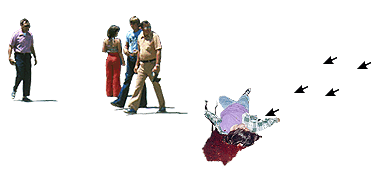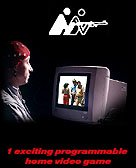The
image displayed on a radar screen may be highly abstract, but it offers
us very specific information about something in real time. Radar is
really nothing more than a video camera with a minimal signal, we
could almost say only just enough signal; a yes or no without explanations,
a here without how, a where ... and a when: now.
But despite transmitting information in real time, the image that
we find between ourselves and that space, the image that makes up
part of the interface, is a representation of (),an interpretation
which leaves out a lot of data or which only retains two items out
of the huge amount that it could reflect.
Throughout history, the power of representation has been centred on
two principle concepts: one, to fool the spectator by creating avatars
of things that are, in fact, inexistent, and the other, to enable
manipulation of things by means of their representation. There are
also representations that actually provide us with more information
than we can see with a simple first glimpse at the reference under
observation, as is the case with perspective, maps, x-rays and so
on.
When representations are used to work on that "something"
that lies behind they become tools, handy operators that enable us
to play a part in a highly specific reality, even while not sharing
the same space. This "something" may be something real or
may be nothing. It may be a representation with no reference, a piece
of fiction in a virtual space, or it could be your neighbour's dog
pissing on the wheel of your bike every day.
Telepresence can encompass two different situations: being "present"
in a computer-created synthetic environment (popularly known as virtual
reality) and being "present" (acting) somewhere remote,
through a video image in real time.
|
|
From
the point of view of simulation technology history, telepresence is
a far more radical technology than virtual reality or any other computer-generated
simulation in general and there is, in fact, a significant difference
between the two: like other falsification technologies that preceded
it (fashion and make up, painting, audio-slide projection, scenery,
fiction films and so on), virtual reality provides the subject with
the illusion of being present in a fictitious world and in addition
allows the subject to have control over a false reality. In contrast,
telepresence offers the chance to physically manipulate the reality
of a space in real time, from a remote site. The operator's body is
linked, in real time, with another physical space where it is able to
act: repair a space station, heal a damaged organ or get rid of the
aforementioned dog.
Thus we could claim that the essence of telepresence is “antipresence”,
or the non-presence of the subject or subjects who physically intervene
in the reality of the place; to be there without “being there”
in real time.
"Today, from thousands of miles away (as was demonstrated during
the Gulf War) we can launch a missile equipped with a television camera
to get close enough to tell the difference between a target and a decoy.
We can direct the flight of the missile using the image transmitted
by its camera, carefully fly toward the target and, using the same image,
blow the target away. All that is needed is to position the cursor over
the right place in the computer image and press a button." (1)
That is the part we like best: the button. The greatest thing about
technology is that it lets us do really complicated things simply by
pressing a button. Would you like to launch a missile directly against
subject 31047D (that damned dog), destroying all the houses in a radius
of 250 metres and mutilating Frank Jones, the unfortunate neighbour
from number 3 who was just passing by, and leaving the little girl who
popped out to buy some bread completely blind, destroying the life of
Mary, her mother, who was watching her from the window, at the same
time injuring the entire poker team from the local bar who were hanging
around together as usual, and a few other things too numerous to mention?
a) Send
b) Leave and send. The truth is that dog breaks my balls every day.
(1)Lev Manovich. En The Robot in the Garden.
Telerobotics and Telepistemology in the age of Internet. Edited by Ken
Goldberg. The MIT press. Cambridge, Massachusetts ©1999
|
In the global
neighbourhood in which we live, the interface that we like most is
the simplest one, the one that does not make us fill out loathsome
questionnaires, the one that does not let us choose and with which
we can make mistakes on a huge scale with just a click of the mouse
button. We no longer have our brains up our arse, nor in our dick,
now, and since some time ago, they are in our finger. That silly finger
we used to use to pick our nose we now use to get everything we need,
want, feel like or do not feel like. With my finger I go to the bank,
and it is my finger that gives me the money and with this finger I
carry out a highly complex operation in the Bahamas and it is this
finger which has enabled me to save the company from bankruptcy....
Basically, that's why I never leave home without it.
It is curious that another word for finger is digit, which comes from
the Latin word digitus.
We wait, counting on our digits and end up controlling digits with digits.
Tele-dígitus is an attempt to emphasise the fact that we press
too many buttons without thinking, without reading the warning messages,
without bearing in mind what lies beyond this action: that behind an
interface there is something more than just digits, that some buttons
prick and do certain other things..
|



